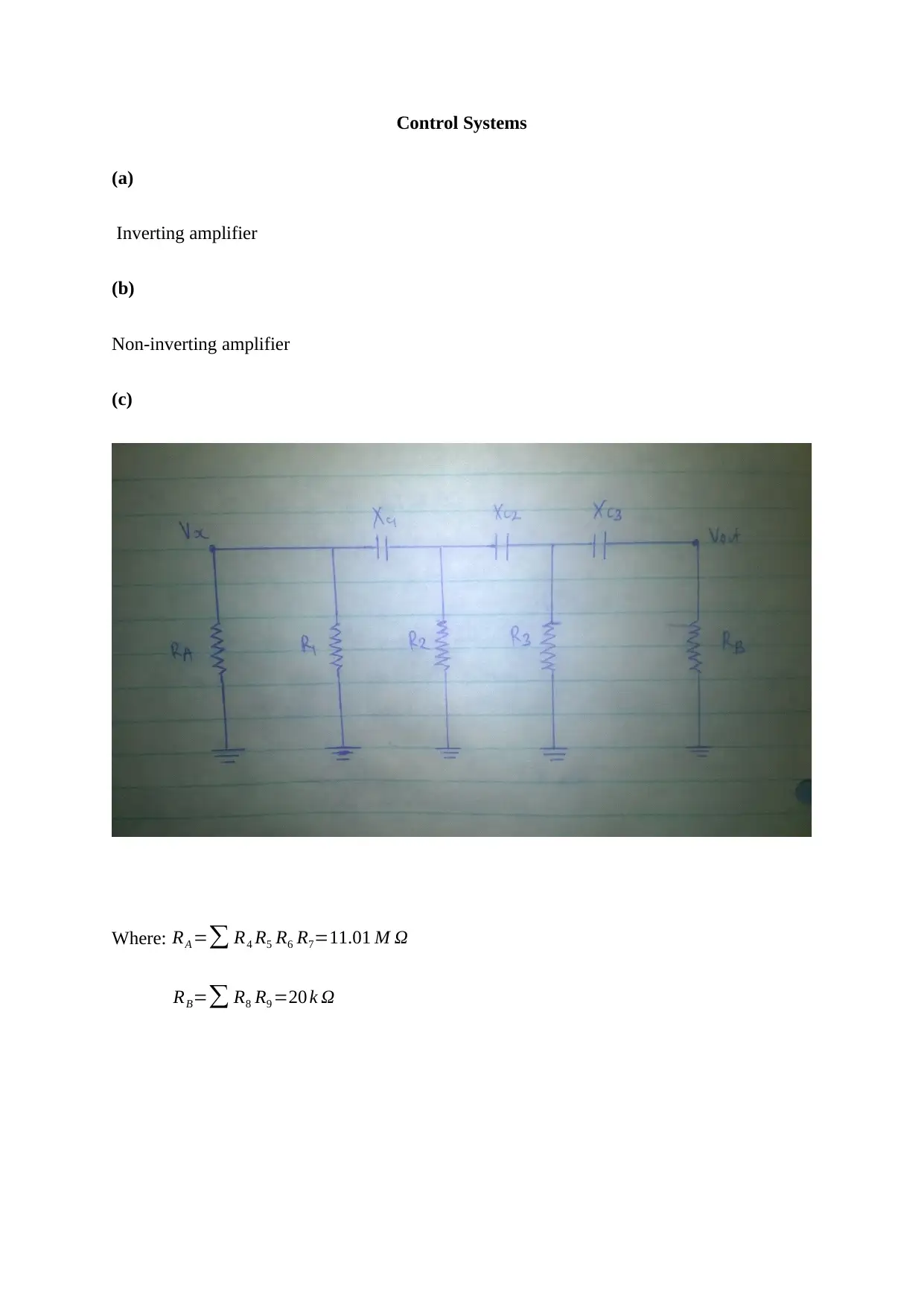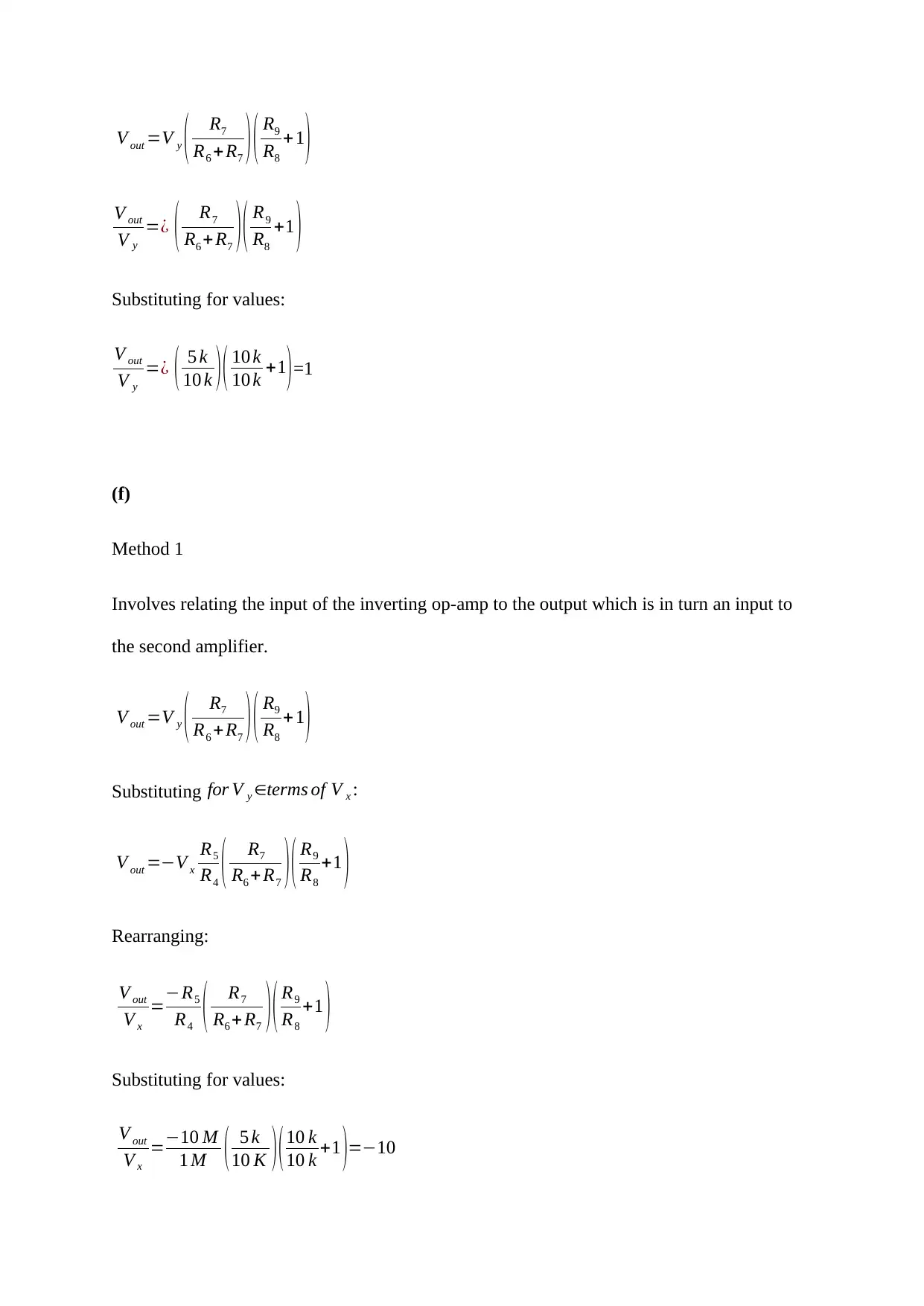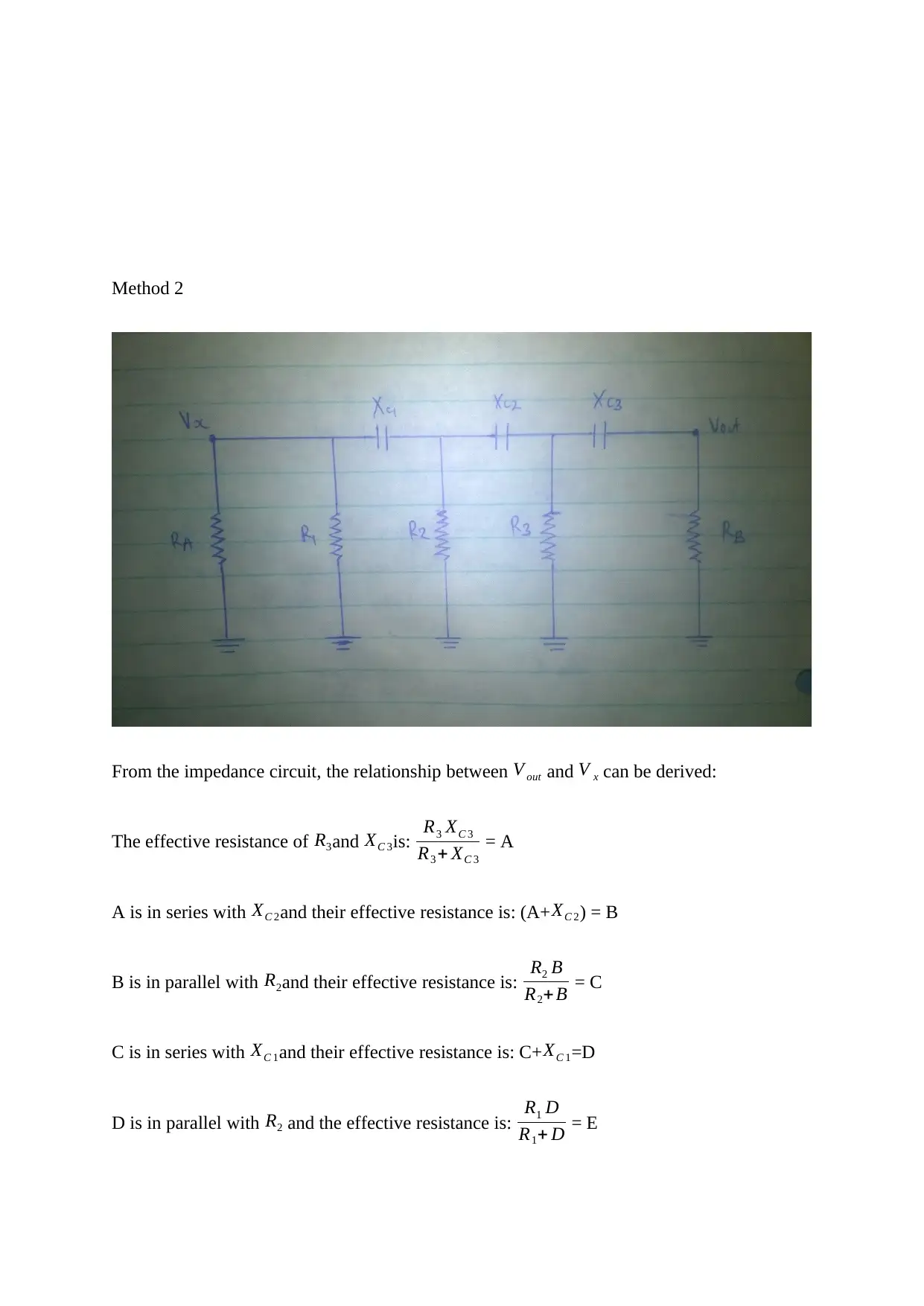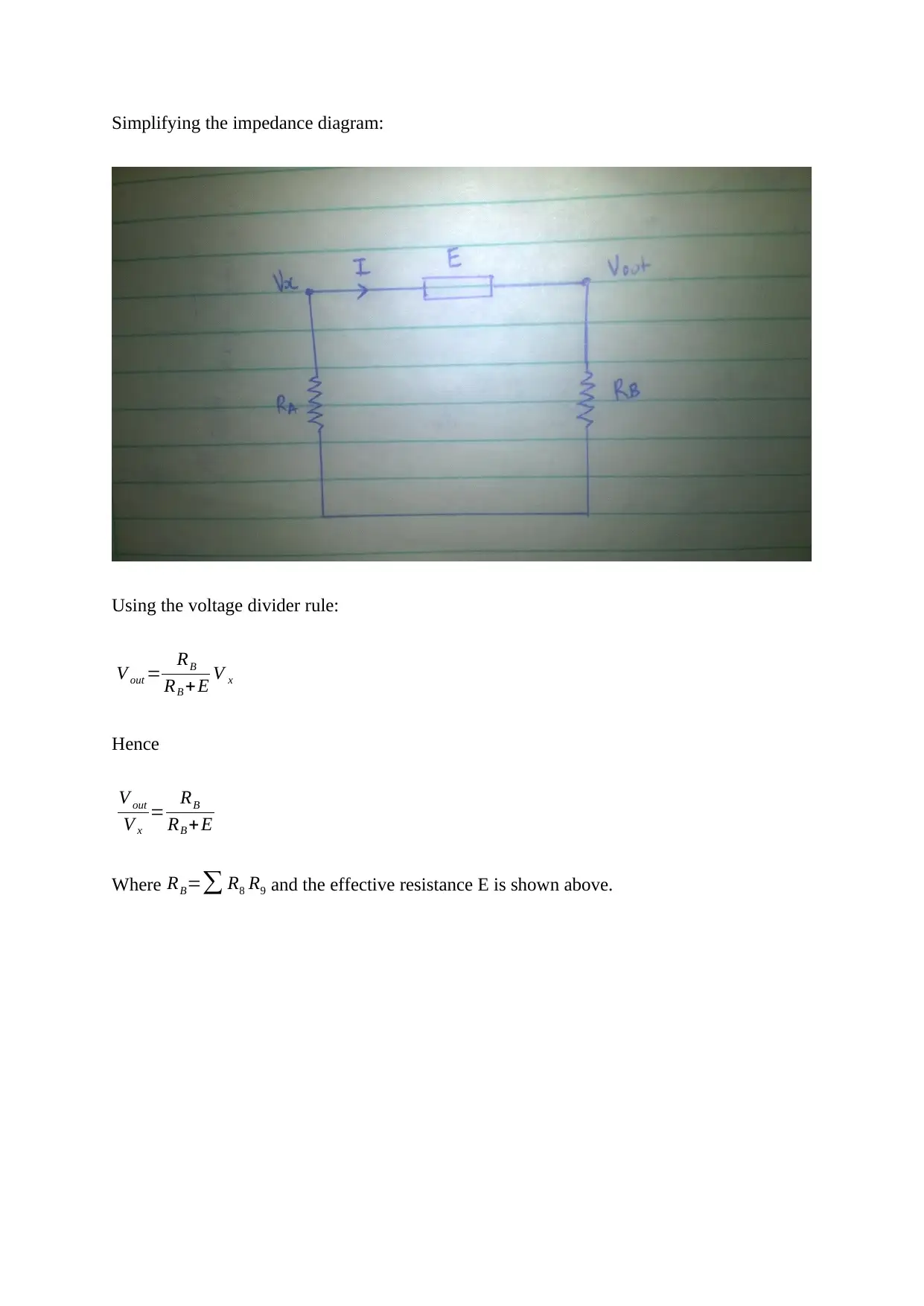Analysis of Amplifiers in Control Systems Assignment
VerifiedAdded on 2023/01/18
|5
|473
|66
Homework Assignment
AI Summary
This assignment solution focuses on the analysis of inverting and non-inverting amplifiers within a Control Systems context. The solution begins by defining the components and parameters of the circuit, including resistor values and relationships. It then proceeds to derive the output voltage equation...

Control Systems
(a)
Inverting amplifier
(b)
Non-inverting amplifier
(c)
Where: RA =∑ R4 R5 R6 R7=11.01 M Ω
RB=∑ R8 R9 =20 k Ω
(a)
Inverting amplifier
(b)
Non-inverting amplifier
(c)
Where: RA =∑ R4 R5 R6 R7=11.01 M Ω
RB=∑ R8 R9 =20 k Ω
Paraphrase This Document
Need a fresh take? Get an instant paraphrase of this document with our AI Paraphraser

(d)
For the inverting amplifier:
V y=−V x
R5
R4
V y
V x
=−R5
R4
Substituting for values:
V y
V x
=−10 M
1 M =−10
(e)
For the non-inverting amplifier:
Assigning an arbitrary value, V y
' at the positive input of the second amplifier due to the
voltage divider
V y
' =V y
R7
R6 + R7
...(i)
The output, V out is expressed as:
V out
V y
' = R9
R8
+1
Making V out the subject:
V out =V y
'
( R9
R8
+1 ) ....(ii)
Substituting (i) into (ii)
For the inverting amplifier:
V y=−V x
R5
R4
V y
V x
=−R5
R4
Substituting for values:
V y
V x
=−10 M
1 M =−10
(e)
For the non-inverting amplifier:
Assigning an arbitrary value, V y
' at the positive input of the second amplifier due to the
voltage divider
V y
' =V y
R7
R6 + R7
...(i)
The output, V out is expressed as:
V out
V y
' = R9
R8
+1
Making V out the subject:
V out =V y
'
( R9
R8
+1 ) ....(ii)
Substituting (i) into (ii)

V out =V y ( R7
R6 +R7 )( R9
R8
+1 )
V out
V y
=¿ ( R7
R6 + R7 )( R9
R8
+1 )
Substituting for values:
V out
V y
=¿ ( 5 k
10 k )( 10 k
10 k +1)=1
(f)
Method 1
Involves relating the input of the inverting op-amp to the output which is in turn an input to
the second amplifier.
V out =V y ( R7
R6 +R7 )( R9
R8
+1 )
Substituting for V y ∈terms of V x :
V out =−V x
R5
R4 ( R7
R6 + R7 )( R9
R8
+1 )
Rearranging:
V out
V x
=−R5
R4 ( R7
R6 + R7 )( R9
R8
+1 )
Substituting for values:
V out
V x
=−10 M
1 M ( 5 k
10 K )(10 k
10 k +1 )=−10
R6 +R7 )( R9
R8
+1 )
V out
V y
=¿ ( R7
R6 + R7 )( R9
R8
+1 )
Substituting for values:
V out
V y
=¿ ( 5 k
10 k )( 10 k
10 k +1)=1
(f)
Method 1
Involves relating the input of the inverting op-amp to the output which is in turn an input to
the second amplifier.
V out =V y ( R7
R6 +R7 )( R9
R8
+1 )
Substituting for V y ∈terms of V x :
V out =−V x
R5
R4 ( R7
R6 + R7 )( R9
R8
+1 )
Rearranging:
V out
V x
=−R5
R4 ( R7
R6 + R7 )( R9
R8
+1 )
Substituting for values:
V out
V x
=−10 M
1 M ( 5 k
10 K )(10 k
10 k +1 )=−10
You're viewing a preview
Unlock full access by subscribing today!

Method 2
From the impedance circuit, the relationship between V out and V x can be derived:
The effective resistance of R3and XC 3is: R3 XC 3
R3 + XC 3
= A
A is in series with XC 2and their effective resistance is: (A+ XC 2) = B
B is in parallel with R2and their effective resistance is: R2 B
R2+ B = C
C is in series with XC 1and their effective resistance is: C+ XC 1=D
D is in parallel with R2 and the effective resistance is: R1 D
R1+ D = E
From the impedance circuit, the relationship between V out and V x can be derived:
The effective resistance of R3and XC 3is: R3 XC 3
R3 + XC 3
= A
A is in series with XC 2and their effective resistance is: (A+ XC 2) = B
B is in parallel with R2and their effective resistance is: R2 B
R2+ B = C
C is in series with XC 1and their effective resistance is: C+ XC 1=D
D is in parallel with R2 and the effective resistance is: R1 D
R1+ D = E
Paraphrase This Document
Need a fresh take? Get an instant paraphrase of this document with our AI Paraphraser

Simplifying the impedance diagram:
Using the voltage divider rule:
V out = RB
RB + E V x
Hence
V out
V x
= RB
RB + E
Where RB=∑ R8 R9 and the effective resistance E is shown above.
Using the voltage divider rule:
V out = RB
RB + E V x
Hence
V out
V x
= RB
RB + E
Where RB=∑ R8 R9 and the effective resistance E is shown above.
1 out of 5
Your All-in-One AI-Powered Toolkit for Academic Success.
+13062052269
info@desklib.com
Available 24*7 on WhatsApp / Email
![[object Object]](/_next/static/media/star-bottom.7253800d.svg)
Unlock your academic potential
© 2024 | Zucol Services PVT LTD | All rights reserved.


